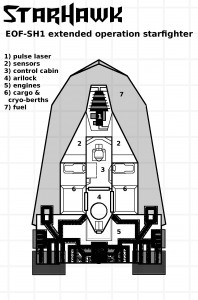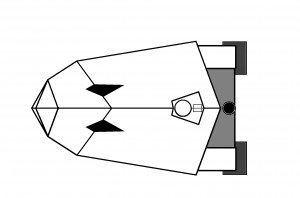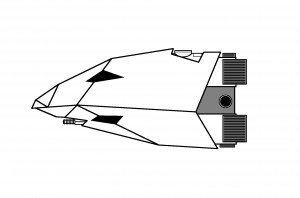EOF-HK1 Starhawk Extended Operations Fighter
30 tons – 25.3854 MCr.
Designed by the Empire to be carried by WPR-4F-ER warp boost rings, Starhawks can travel four parsecs at a jump. Because of this they are used extensively as armored couriers, forward scouts, or to transport small teams of agents. Some Imperial carrier fleets will scout nearby parsecs with patrols of these ships. They also serve well as ground attack fighters. Their versatility and the inclusion of a tiny galley and fresher in the cabin led to the HK1 gaining the nickname Kitchen Sink, as in “I’m on kitchen sink duty this week scouting the next sector.”
The three ton crystaliron armored hull acts as a lift body, making the Starhawk a flying wing with excellent atmospheric performance. Built tough, they can generally survive anything short of particle beam fire. Under the armor the four ton hydrogen fuel tanks provide a secondary layer of protection for the central cabin. This heavy frontal armor profile excludes a canopy or windows – instead views from sensors on the hull are presented to the pilot in a holographic display that integrates telemetry and targeting data.
As extended-operations fighters Starhawks feature extras that allow the pilot some comfort during missions. Instead of a cramped cockpit the fighter is piloted from a control cabin. If necessary, a humanoid can turn off the artificial gravity and sleep in the small fresher, per standard Imperial patrol procedure on these craft. There are also two cold berths for transporting passengers, extra crew, or for the pilot’s use during long flights. These cryo-berths can be set to automatically wake the occupants at a set time or as the ship is coming out of warp. There is also cargo capacity for three tons. The cargo spaces are equipped with small seats that fold into the walls, allowing the Starhawk to transport a small fire team.
They are also equipped with a repair or astromech droid, providing in-space repair ability and/or a robotic co-pilot. These can be replaced by a drone but the onboard computer does not usually have the capacity to run a repair program, leaving the pilot to operate the repair drone.
Other extras include probe drones and an airlock, giving them capability to perform search, rescue and repair operations. Often patrol duty will involve picking up or dropping off probe droids to be retrieved by the next patrol.
Starhawks are a TL 12 standard design subject to the %10 cost discount.
System – Details – Tons – Cost (MCr)
Hull – 0 points, streamlined – 30 tons – 1.43 MCr.
Structure – 1 points
Armour – 8 points crystaliron – 3 tons – 0.286 MCr.
Power Plant – class sM – 5.1 tons – 9 MCr.
Maneuver Drive – thrust 8 – class sM – 7 tons – 14 MCr.
Control Cabin – 3 tons – 0.15 MCr.
Crew – 1 pilot
Computer – model 1 – rating 5 – 0.03 MCr.
Software – fire control 1, library – 2 MCr.
Electronics – basic civilian: radar, lidar – 1 ton – 0.05 MCr.
Weapons – fixed mount TL10 pulse laser (long range, accurate, high yield) – 1 ton – 0.6 MCr.
Fuel – 4 weeks of operations – 4 tons
Cargo Capacity – 3 tons
Extras – airlock – 1 ton – 0.2 MCr.
– repair drone (1) – 0.3 tons – 0.06 MCr.
– probe drones (3) – 0.6 tons – 0.3 MCr.
– low berth (2) – 1 ton – 0.1 MCr.
Maintenance Cost (monthly) – 2,115 Cr.
Life Support Cost (monthly) – 200 Cr.
Posted in Starship, Traveller by Adam A. Thompson with no comments yet.



[…] A longer-range version of the WPR-A2, this chassis is mainly used to move ships such as modular skiffs or retrieval boats across the cosmos at warp 4. WPR-F-4 were originally designed to carry Starhawk extended range fighters. […]